Green Curry Recipe (Gaeng Khiao Wan Kai) is a spicy, creamy, and fragrant Thai dish with chunks of chicken and Asian green eggplants. This vibrant curry is so versatile that you can tweak it with your choice of protein, veggies and even spiciness. Well-known for its earthy, sweet, and sour flavors in Thai cuisine, you would not want to give it amiss, especially when it is homemade!
Origin:
And where would I be without the history? The dish itself was first referenced by a Thai author in the late 1920s. It was a time of great change in Thai history moving from a full monarchy into a more democratic constitutional monarchy. In many parts of the world but more so in Asia, the color “green” has always been seen as a color of renewal and rejuvenation, and the Green Curry recipe symbolizes that.
The dish itself is not mild, but I’ve improvised on the original recipe that I picked up in Bangkok, by adding nutmeg and mace, which I believe brings the natural flavors of the other ingredients, giving it an earthy richness.
One of the most ubiquitous dishes served in Thai restaurants around the world is the Green Curry. Some of my friends insist that the Green Curry recipe is sweeter and milder than its red cousin, while others speculate that it is the use of coriander that delivers the sweet, green vibrancy.
In my opinion, both statements fit into the category of urban legend. Let’s begin with the name. In Thai, the Green Curry is called Kaeng Khiao Wan.
- Kaeng/Gaeng – A misnomer to call it curry. Kaeng or Gaeng is a name for a range of dishes from a thick soup to a broth. Based on its thickness, it can be called a curry.
- Khiao – green
- Wan – sweet
The ‘Wan’ or sweet here refers to the color of the green. It’s sweet green (like paint colors “Happy Blue” or “Passive Gray”). Hence it is the ‘Sweet Green Curry’.
How does the Green Curry get its color and flavor?
Back to my urban legends! The mildness is from the coconut cream and the sweetness can be attributed to the use of coconut cream or palm sugar. These are common techniques that South and Southeast Asian cuisines use. The traditional Thai Green Curry recipe calls for the use of green bird’s eye chilis, which have a Scoville score (SHU or Scoville Heat Units) of between 50,000 SHU and 150,000 SHU. Compare that to the ordinary jalapeño which has about 2,500 SHU.
Secondly, the color. Most curries range from a light brown to a bright orange because they use woody spices such as cinnamon, nutmeg, cloves, and the star anise. The most salient trait of the Green Curry recipe is that it is green, making it unlike any other curry. Many mistakenly attribute the green color only to the use of coriander or cilantro leaves.
While Thai and Southeast Asian cuisine use coriander or cilantro, one basic tenet of this green spice is that it oxidizes to brown after a couple of hours. If the plan is to turn cilantro leaves into a green paste, it will become brown (just like the avocado) in a matter of hours. The same is not true of cilantro roots which oxidize much more slowly than the leaves. Traditionally, it is the ground roots that provide that cilantro flavor for this curry. So, if you see that the “green” curry is greenish-yellow, it’s not that it’s not a green curry. It just means that the cilantro leaves in the paste may have oxidized before being rendered.
The color does not come from cilantro alone. So where does the green in the Green Curry recipe come from? Well for the most part, it comes from the use of green bird’s eye chili, which is the signature spice for this dish. It also comes from the use of the Thai green pea eggplant (which I’ve found to be a wonderful sweet-tasting eggplant). The Thai pea eggplant is different from the green eggplant which I’ve heard as being referred to as the ‘Green Elephant Tusk Eggplant.” The color is also balanced through the use of makrut lime leaves, fresh (almost white) galangal, and lemongrass. Natural curries are always going to have some version of brown because of the cooking process.
My husband’s compulsory military training for a few months in Bangkok exposed him to several cooking techniques. He learned simpler ways to cook Thai food using store-bought curry pastes as part of his survival training in the jungles. Needless to say, store-bought pastes are a quick fix whenever you feel like having some spicy food. But the Green Curry Recipe is a more authentic way of making it with homemade spice paste.
What is the difference between Panang curry and Green Curry recipes?
Panang Curry is much thicker and richer than the Green Curry recipe. Although peanuts are optional in the Panang curry, thick coconut cream or milk is added to give a slightly sweeter taste and hence is less spicy than the Green Curry. Sometimes Panang curry is served with rice on a plate rather than in a bowl whereas the Green Curry is lighter in consistency and is served in a bowl.
Frequently Asked Questions:
1. What makes the green curry green?
Grinding the green chilis with whole cilantro contributes to the green color of the curry. Optionally, grind some Thai basil for a greener curry.
2. How do I make the Green Curry Recipe less spicy?
The spiciness is relative. If you want to make it less spicy, dial back the number of Thai green chilis and peppercorns. You can also tone down the heat by adding more coconut milk.
3. What are some variations of this curry?
Swap out the chicken for tofu, shrimp or even fish fillets. Please feel free to add other veggies such as carrots, snow peas or bamboo shoots.
If you’ve tried this recipe or have questions, I would love to hear from you. Please feel free to share (below) your thoughts, comments, or any questions that you might have. And if you like my recipes, you could subscribe to my mailing list for the latest recipes that will be delivered straight to your inbox. From my pen to your table, Bon Appetit!
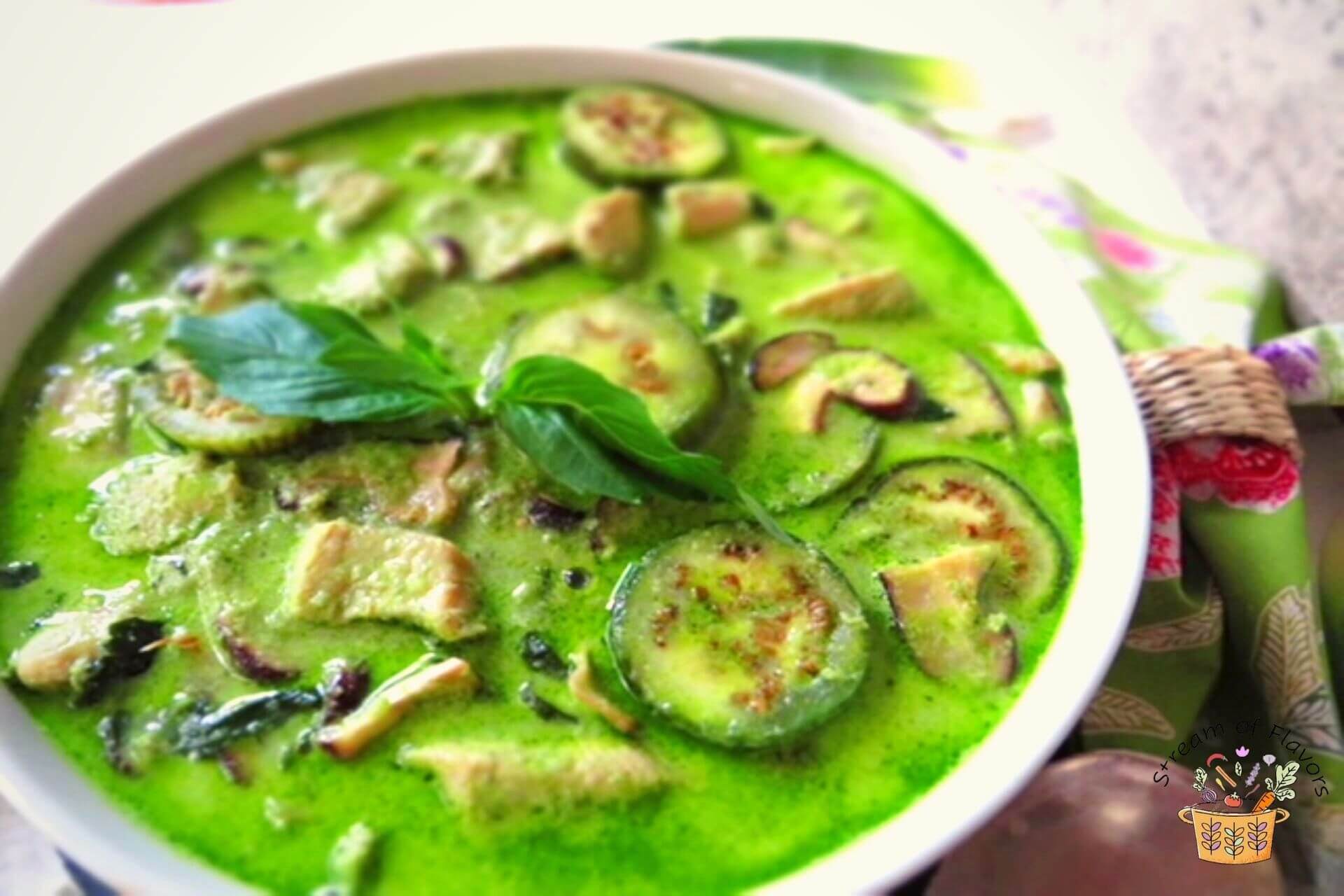
Ingredients:
I usually plan my menu for the week ahead and do my grocery shopping accordingly. This might seem like an elaborate list of ingredients. These ingredients are integral to making the Green Curry using my recipe as they will differentiate between homemade and store-bought. Once you have the ingredients in line, the rest will fall in place easily. Some ingredients are quite basic in every kitchen but others must be purchased ahead of time and added to this recipe.
One of the questions I get quite often is what to do with the ingredients that are left over from making this recipe. If you have leftover ingredients, you could try making Laksa Lemak, Sayur Lodeh, and the Baked Pomfret.
For the curry:
- Oil: virgin coconut oil
- Veggies: Thai pea eggplant or use any small eggplant; additionally, feel free to use snow peas, carrots, or peppers
- Aromatics: dried or fresh makrut lime leaves (can be purchased frozen from Asian stores), lime or lemon zest, Thai basil leaves or you could substitute with any other basil if you absolutely cannot find them, and garlic
- Protein: fresh shiitake mushrooms, if you are using dried shiitake, please soak them in hot water until they are soft for a few minutes and then slice them: you could swap out the chicken for tofu
- Thickener: I used fresh coconut milk or substitute it with coconut cream or canned coconut milk (canned coconut milk will make the curry very thick)
For the curry paste:
- Oil: coconut oil or peanut oil
- Aromatics: Asian shallot or pearl onion, galangal is essential (alternatively use fresh ginger), cilantro – root and/or stalks, lemongrass – white part only, garlic
- Dried shrimp: small dried shrimp that are available in Asian supermarkets – soak in lukewarm water and then grind with the rest of the ingredients.
- Dried spices: mace, nutmeg, cumin seeds, coriander seeds, black peppercorns
- Fresh spice: Thai green chili is essential like most other ingredients when making Thai food. It contributes to the green color, flavor, and heat of the Green Curry recipe. Other kinds of green chilis may be used if you cannot find the Thai variety.
- Liquid: Coconut milk diluted from second extraction if making fresh, otherwise please use water
- Sugar: coconut palm sugar or brown sugar
How to make the Green Curry using my recipe:
For the curry paste:
- Prepare the ingredients.
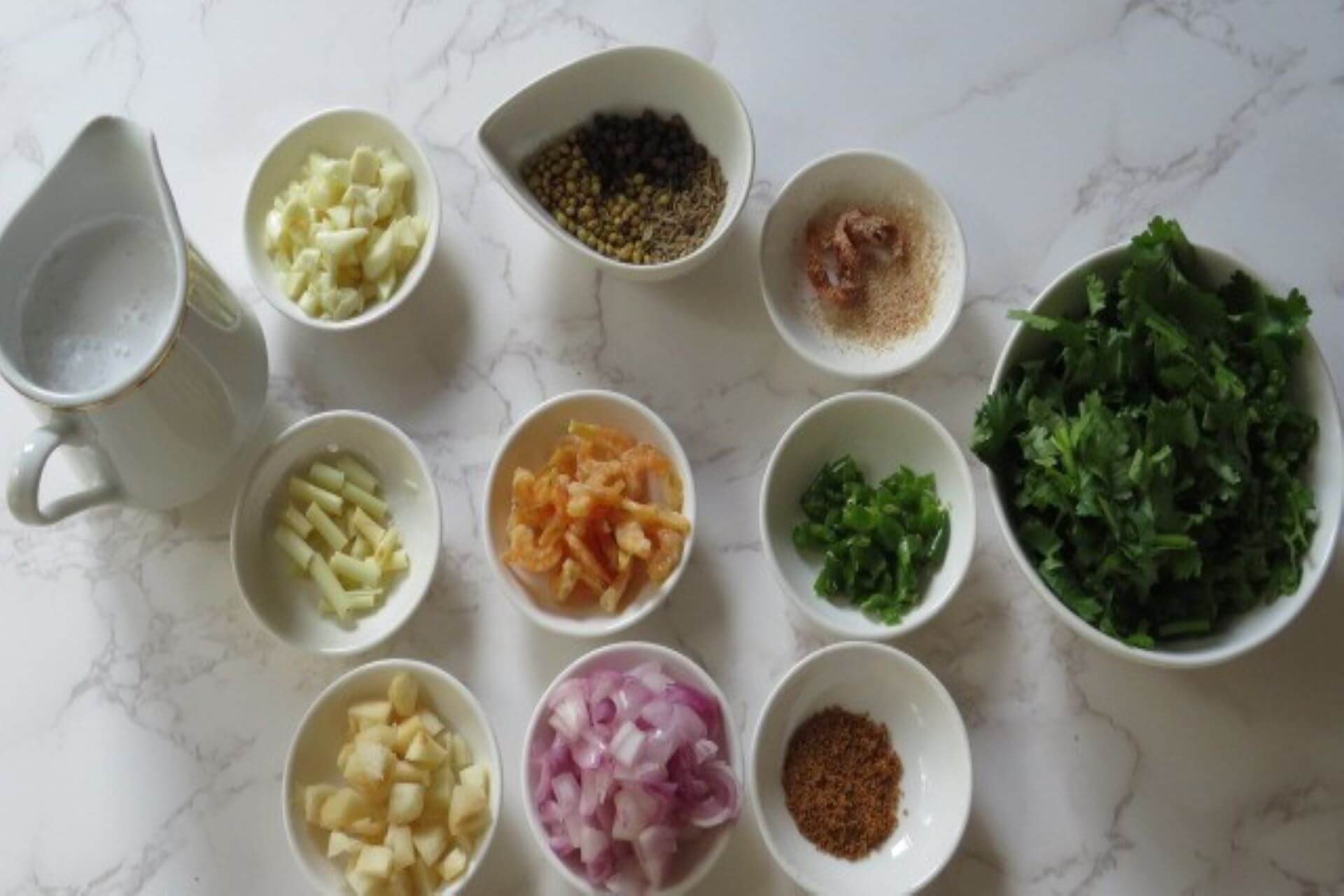
2. Roast the cumin, coriander seeds, and black peppercorns for a minute. Cool and grind in a food processor or grinder. Add the remaining ingredients for the curry paste and grind together to form a smooth paste. Keep aside.
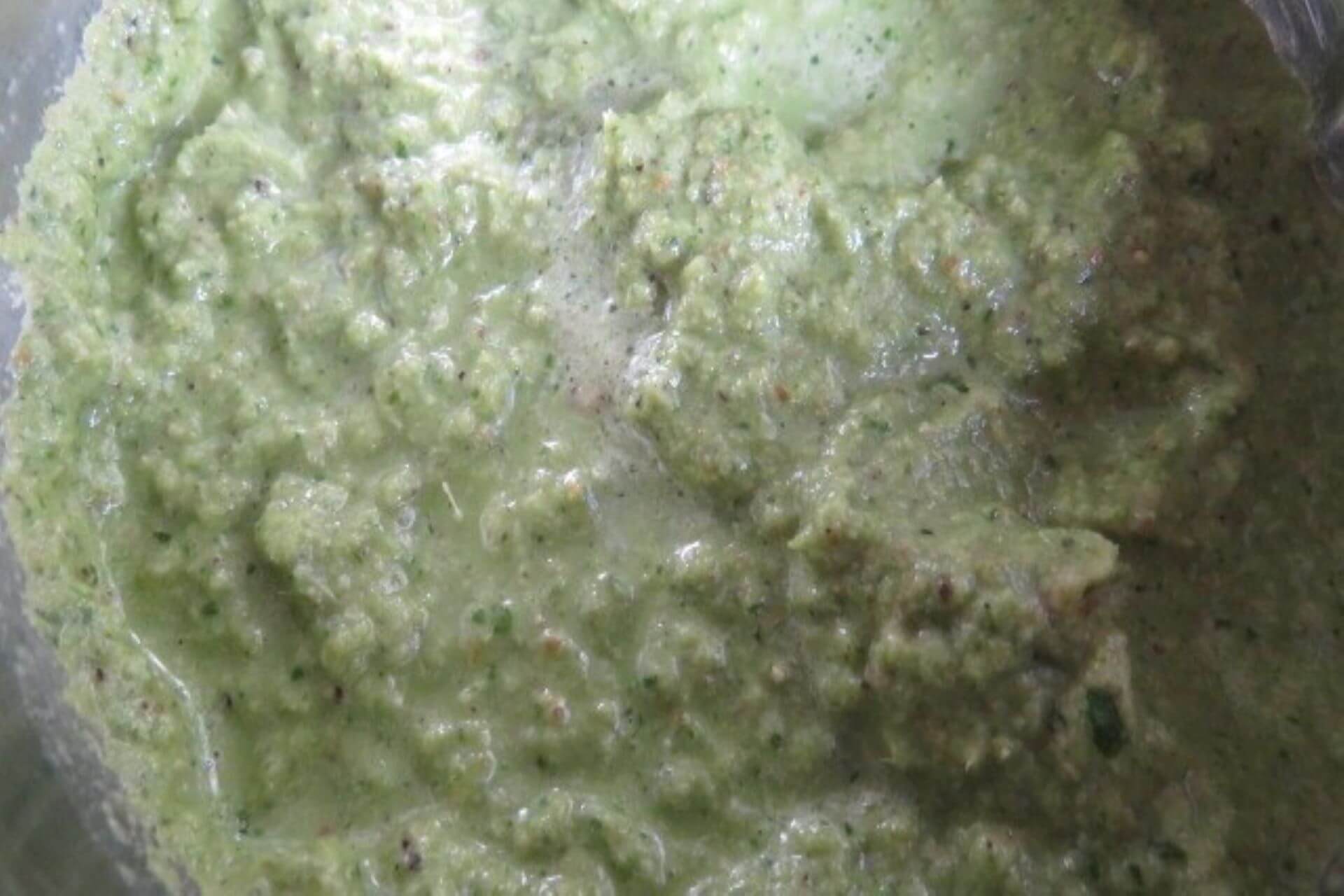
For the curry:
- Prepare the ingredients for the curry.
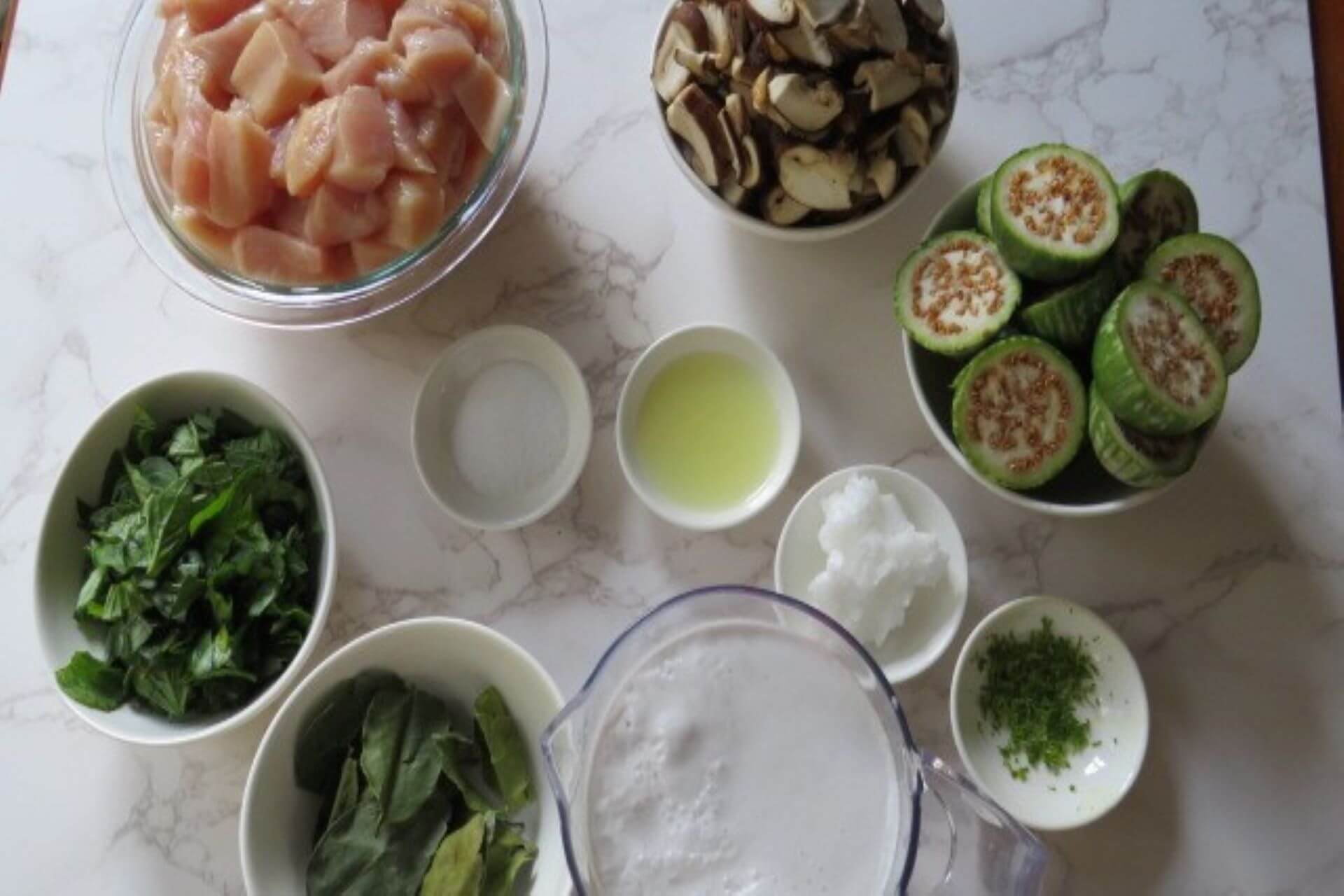
2. Heat a wok, add a teaspoon of coconut oil and the garlic, and sauté the sliced mushrooms for 2-3 minutes. Remove the mushrooms and keep aside.
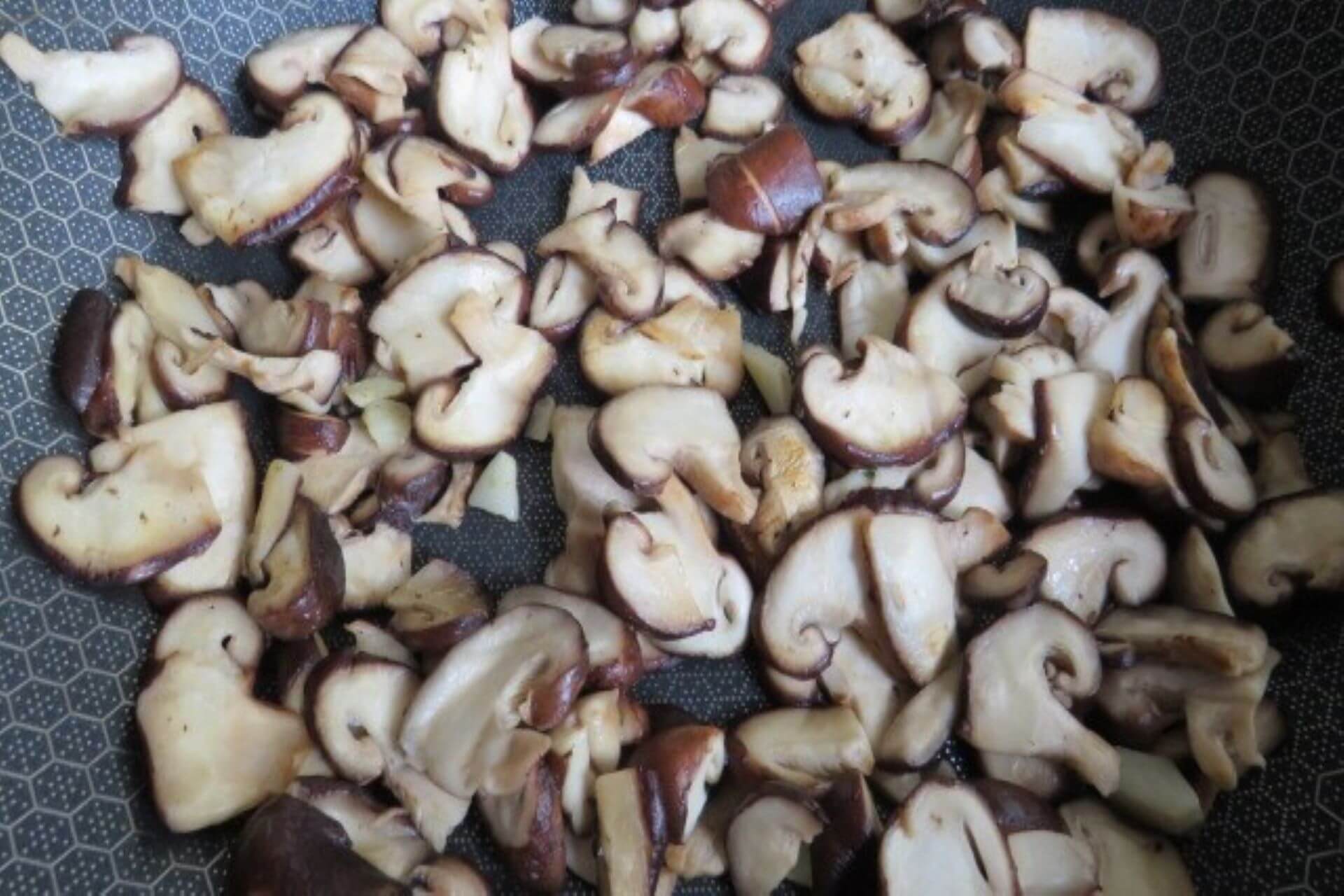
3. To the same wok, add the coconut oil and the curry paste and sauté for 3-4 minutes on medium heat or until fragrant. Add salt and the lime zest.
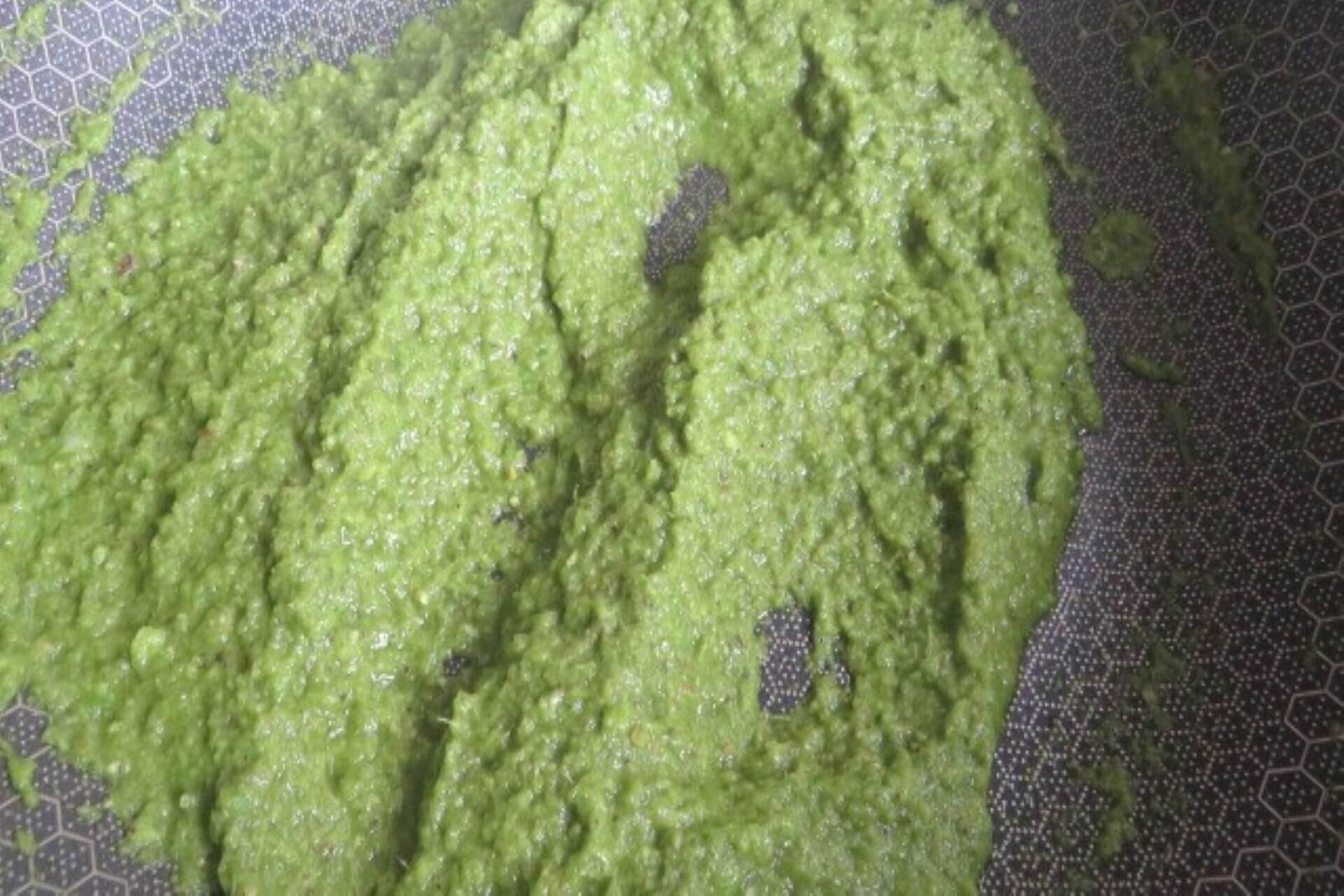
4. Add the chicken pieces and cook for 10 minutes.
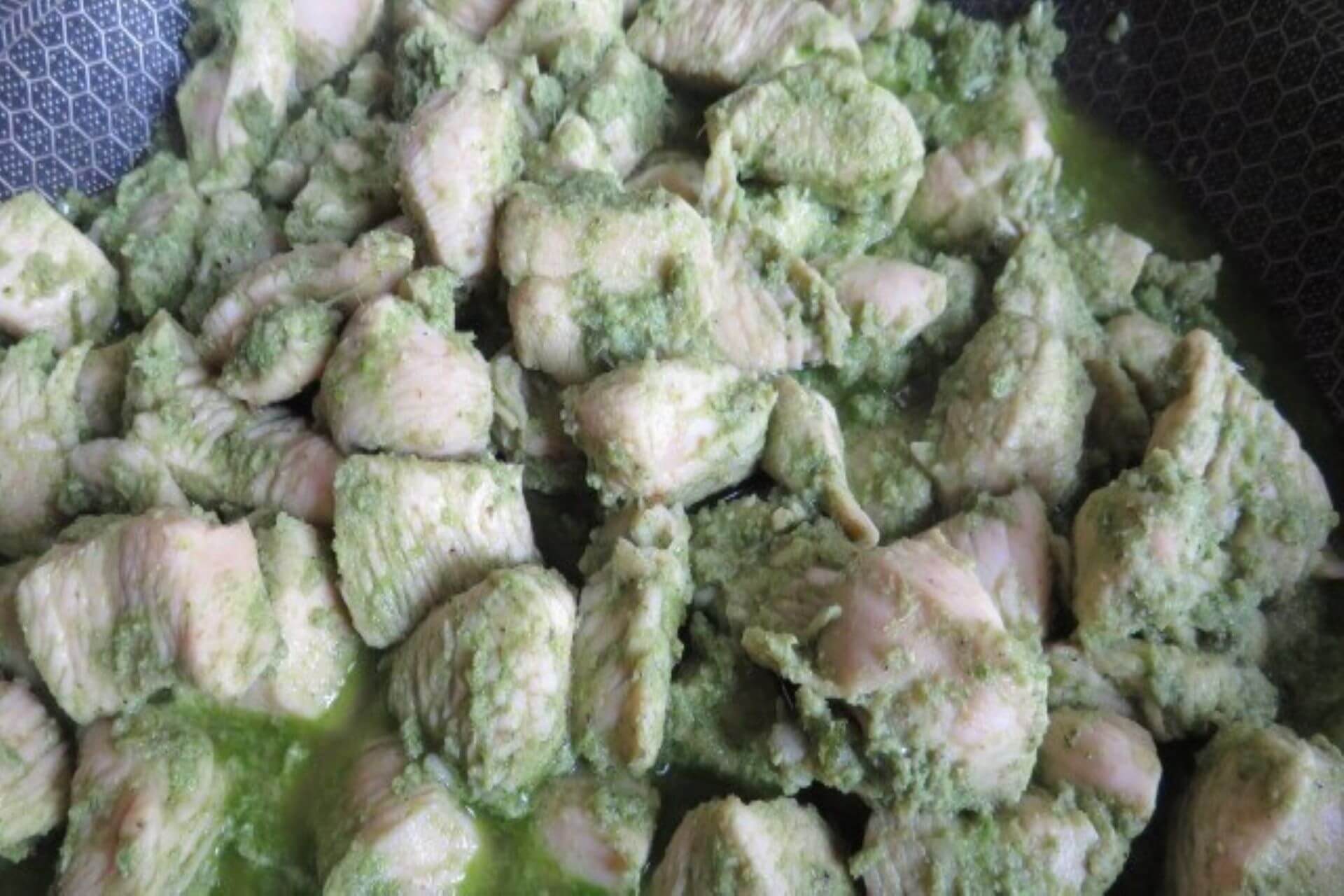
5. Add the makrut lime leaves, eggplant and half the coconut milk and cook for 10 minutes with a lid on.
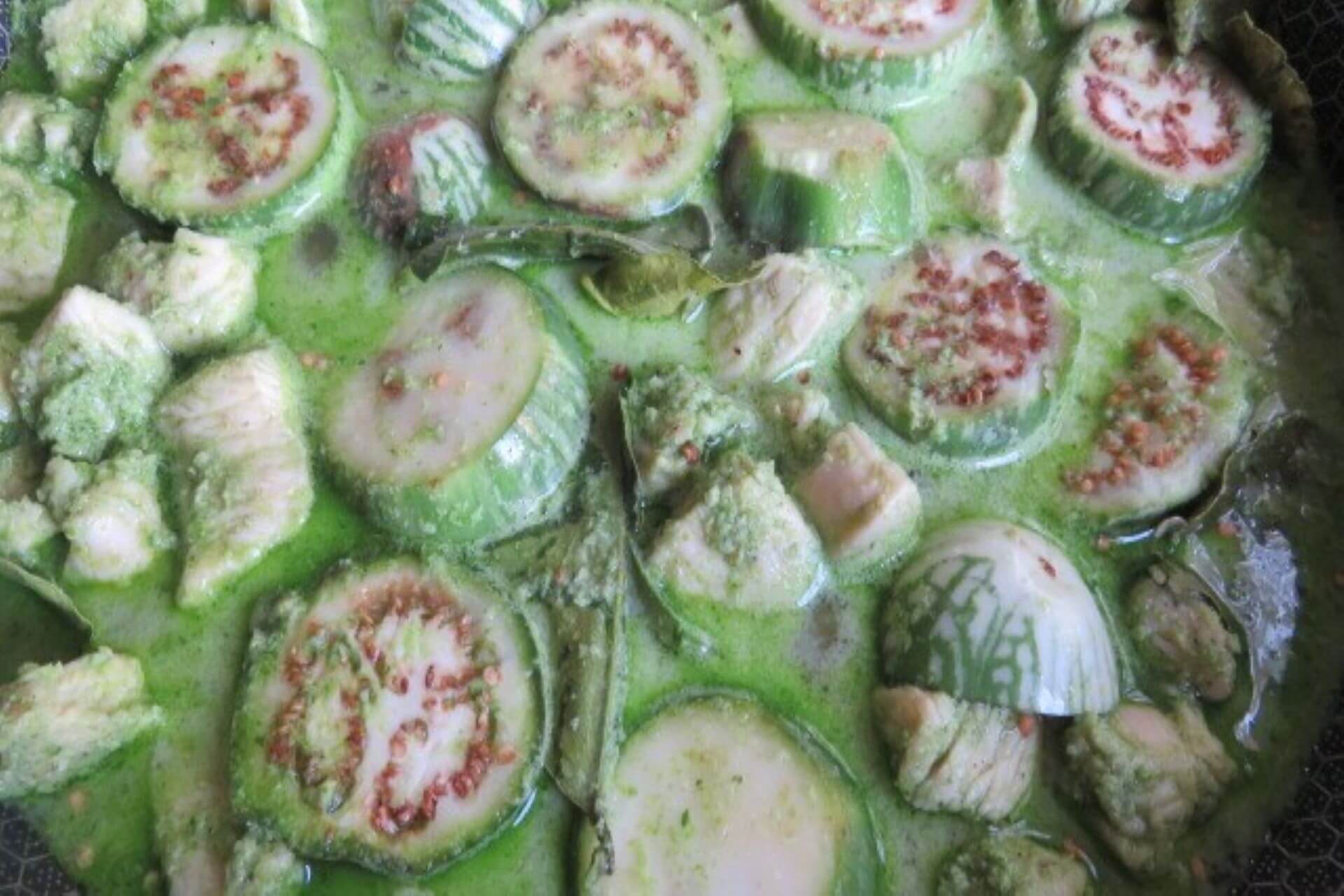
6. Toss in the basil leaves and the remaining coconut milk and the mushrooms. Turn off the heat when it boils. Add the lime juice and stir well.
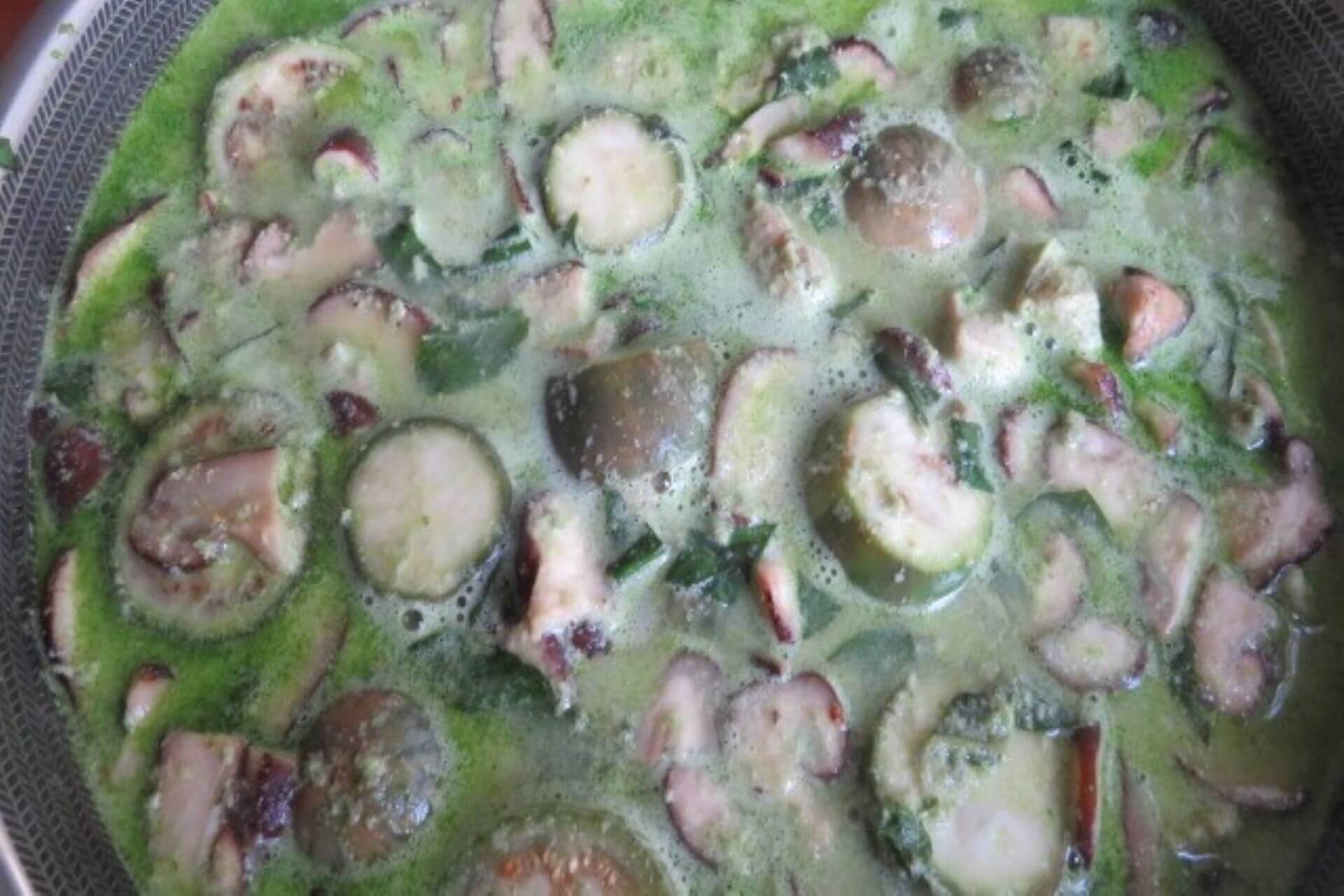
7. Serve hot garnished with basil leaf on a bed of steamed jasmine rice.
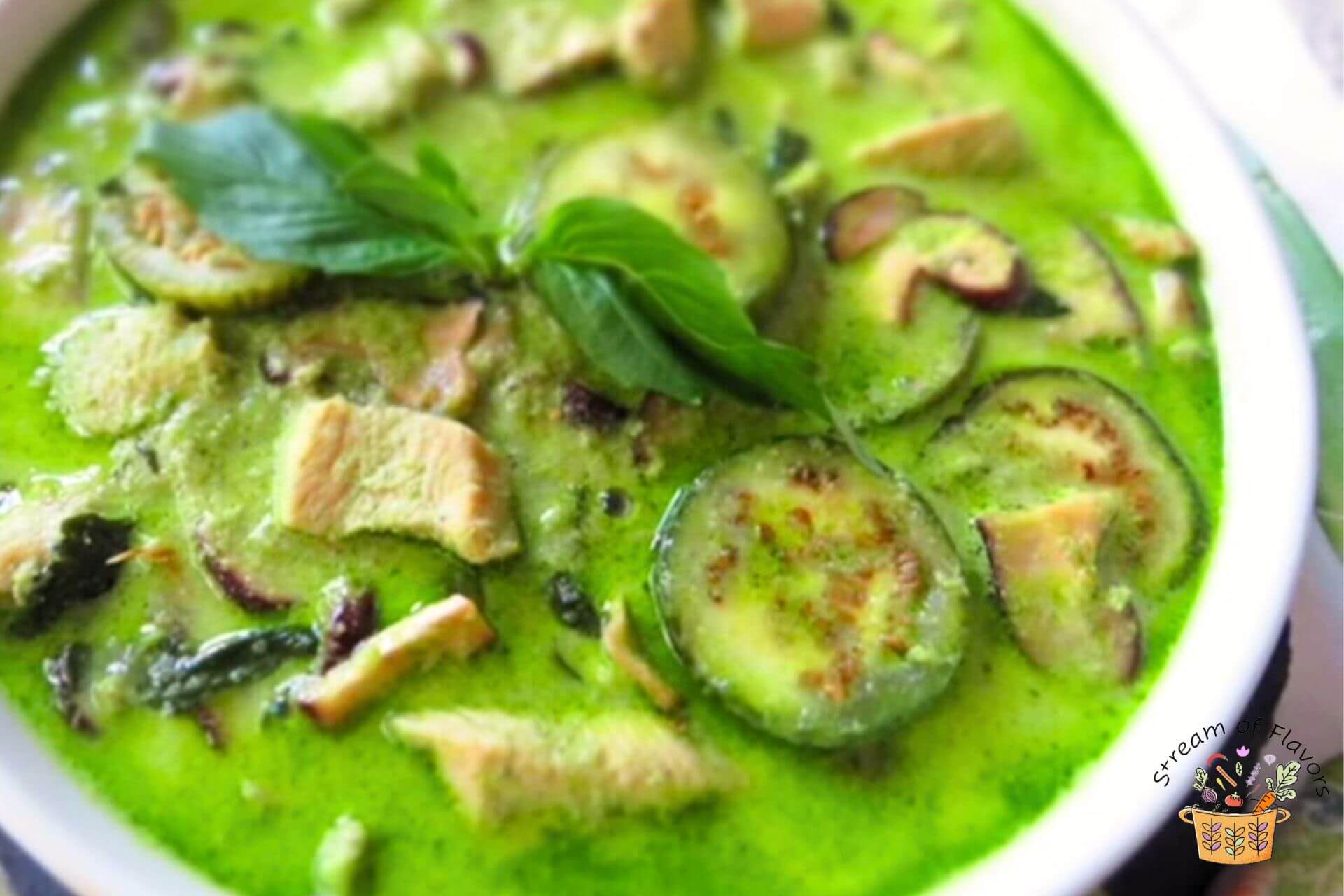
1. Sauté the curry paste until fragrant for a more robust flavor.
2. Please do not toss all the ingredients in one go. Layer the ingredients depending on the corresponding cooking times. Adding the pea eggplants to the chicken will result in overcooked vegetables.
3. Add umami to the Green Curry recipe by sautéing the shiitake mushrooms.
4. Handling the pith and seeds directly with your fingers will result in a burning sensation for some time. Remove the seeds and pith from the chilis by wearing a pair of gloves to reduce the heat in the curry.
Serving suggestions:
The Green Curry is perfect when served on a bed of warm steamed rice. It can also be served with the Thai Pineapple Fried Rice.
Storage recommendations:
The Green Curry can be refrigerated for two days in airtight containers or frozen for three months. If using fresh coconut milk, I highly recommend that you consume it within two days.
Green Curry Recipe
Equipment
- Wok
Ingredients
For the curry:
- 1 tbsp coconut oil virgin, unrefined
- 1 clove garlic
- ¼ lb shiitake mushroom fresh, sliced
- 2½ lb chicken breast boneless, cubed
- 6 makrut lime leaves dried, frozen
- ½ tsp lime zest
- 1¾ tsp salt
- ½ lb Thai pea eggplant discs or quartered
- ¼ cup Thai basil leaves chopped
- 2 cup coconut milk fresh
- 1 tbsp lime juice
For the curry paste:
- ¼ cup coconut milk
- 2 tbsp Asian shallot chopped
- 1 tbsp dried shrimp soaked
- 1 tbsp galangal chopped
- 2 tsp coconut palm sugar
- 1 tbsp Thai green chili deseeded, chopped
- 1¼ tbsp garlic chopped
- 1 cup cilantro leaves root, stalks, chopped
- 1 tbsp lemongrass white part
- ¼ tsp nutmeg grated
- 2 petal mace
- 1 tsp cumin seeds
- 1 tsp coriander seeds
- 1 tsp black peppercorn
Instructions
How to make the curry paste:
- Prepare the ingredients.
- Roast the cumin, coriander seeds and black peppercorns for a minute. Cool and grind in a food processor or grinder. Add the remaining ingredients for the curry paste and grind together to form a smooth paste. Keep aside.
How to make the curry:
- Prepare the ingredients for the curry.
- Heat a wok, add a teaspoon of coconut oil and the garlic and sauté the sliced mushrooms for 2-3 minutes. Remove the mushrooms and keep aside.
- To the same wok, add the coconut oil and the curry paste and sauté for 3-4 minutes on medium heat or until fragrant. Add salt and the lime zest.
- Add the chicken pieces and cook for 10 minutes.
- Add the kaffir lime leaves, eggplant and half the coconut milk and cook for 10 minutes with a lid on.
- Toss in the basil leaves and the remaining coconut milk and the mushrooms. Turn off the heat when it boils. Add the lime juice and stir well.
- Serve hot garnished with basil leaf on a bed of steamed jasmine rice.
Video
Notes
- If the curry is too salty, balance it with a squeeze of fresh lime juice.
- Fish sauce is optional, the curry tastes great without it.
- Try adding a little more coconut milk if your curry is too spicy.
Nutrition


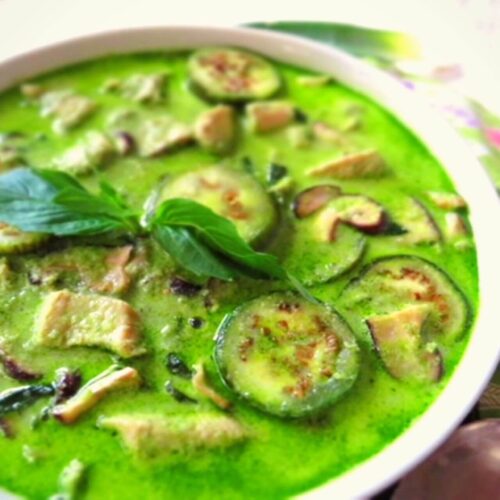

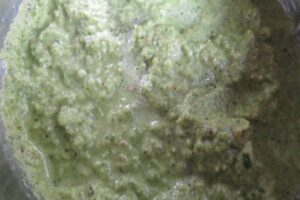
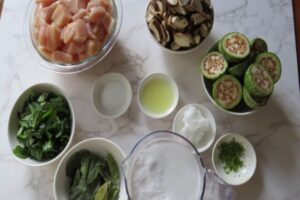
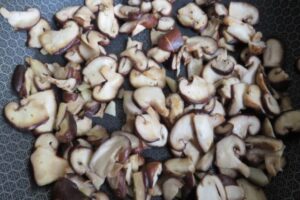
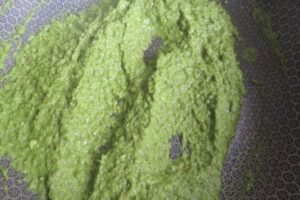
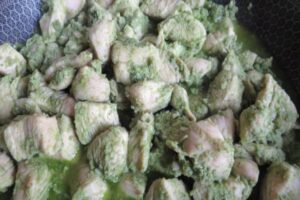
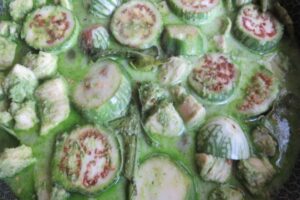
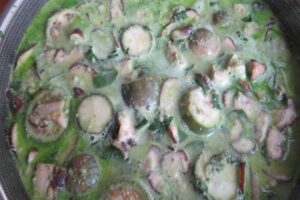
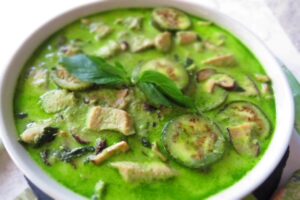





















Greetings from Colorado! I love the knowledge you present here. Anyways, fantastic blog!
Thanks!